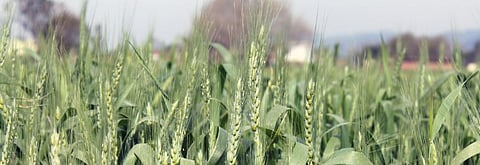

Bihar’s farmers were left praying for a miracle after unseasonal rain and hailstorms since March 12, 2020 damaged rabi crops across the state.
Rabi crops are sown during the winter and harvested by farmers in summer.
Several of these crops — including pulses, mustard, masur (lentil) and wheat — were damaged, according to the state’s agriculture department officials and scientists.
Farmers also feared a decline in vegetable production because of unexpected rain in mid-March, after the festival of Holi. A decline in the production of fruits — including mangoes and litchis — was expected as well.
“It is nature’s curse. Farmers like me have to face a loss of production,” Lakhendar Yadav, a farmer in Bihar’s Gaya district told Down To Earth, adding that his production of masur was affected the most.
Shankar Pandey, a farmer in Rohtas district said four acres of his mustard crop were damaged by sudden rain.
“I am not alone. Mustard and pulse crops of thousands of farmers were affected this time by this rain,” he told DTE.
Masur and mustard crops were the worst-affected, according to experts.
There would be a decline of 30 to 50 per cent in production of masur — much more than other standing crops — said JS Mishra, head of crop research at the Indian Council of Agricultural Research in capital Patna.
There was a chance that the production of both masur and mustard would fall by 25 to 30 per cent across Bihar, according to RK Sohane, director extension at Bihar Agriculture University in Bhagalpur district.
Pulses are cultivated in 5 lakh hectares across Bihar, with the masur crop covering 1.5 lakh hectares, according to the state government’s data.
The annual production of pulses was 4.6 lakh tonnes in Bihar. However, 20 lakh tonnes were needed to fulfil demand.
Bihar received 31.6 mm rain from March 1 to March 14, much higher than regular rain of 3.2 mm during this period, said Arti Gupta, a scientist at the state meteorological department.
Bihar recorded 15.6 mm on March 12, she said.
Gaya recorded the highest rainfall with 43.1 mm, followed by 27.8 mm rain in Rohtas, 20.1 mm in Sabour, 16.7 mm in Patna and 16 mm in Bhagalpur on March 13, according to Met department officer Ravinder Kumar.
Rain occurred due to induced western disturbance in the upper and mid troposphere levels where westerly wind in lower levels carried moisture from the Bay of Bengal’s anti-cyclone system, said Kumar.
Horticulture scientists said the sudden rains would affect mango and litchi crops.
Mango and litchi farmers in the state — particularly in Bhagalpur and Muzaffarpur regions — were increasingly worried about the unpredictable weather.
Litchi was very sensitive to variations in temperature, rainfall and humidity. Climatic variations affected litchi crops more than any other summer fruit, said Abdus Sattar, a climate change expert at the Rajendra Prasad Central Agricultural University in Samastipur district.
Muzaffarpur’s shahi litchi, an Indian variety of soapberry — famous for its size, unique flavor, aroma and taste — could also be a casualty of unpredictable weather.
Farmers who were earlier upbeat about a bumper harvest for the mango crop are now anxious about an increase in insect attacks because of moist weather.
The state’s mango production would be affected, according to them.
Zardalu and malda mango varieties grown in Bhagalpur were also at risk, they said.
Heavy rain damaged Bihar's paddy crops in mid December, 2019. Farmers had then demanded compensation from the state government, but were yet to get any assurances.